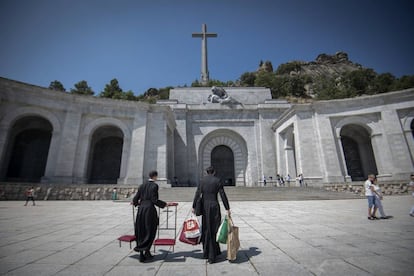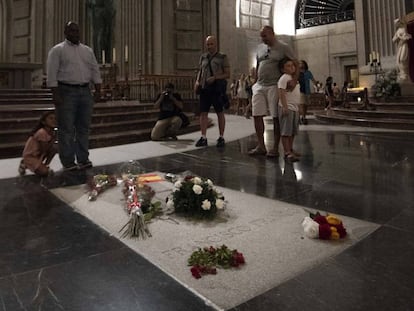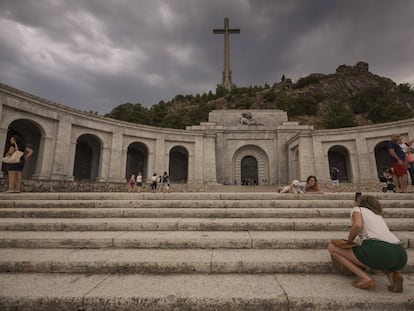Spanish PM backtracks on turning Valley of the Fallen into a museum
Pedro S¨¢nchez argues that the memorial site, where former dictator Francisco Franco is buried, is too charged with symbolic meaning to be a place of reconciliation


Spanish Prime Minister Pedro S¨¢nchez has backed down from a proposal to turn the Valley of the Fallen into a museum for historical memory once the body of former dictator Francisco Franco has been removed from the memorial site.
Last week, the Spanish Cabinet passed a legislative decree to legally safeguard the exhumation of Franco. But doubts remain as to what will happen to the Valley of the Fallen once his remains are exhumed.
S¨¢nchez said removing Franco¡¯s remains was proving ¡°more difficult¡± than he first thought
Speaking to the press on his ongoing diplomatic tour of South America, S¨¢nchez said the site was too charged with symbolic meaning to be turned into a ¡°place of reconciliation.¡± Instead, the Socialist Party (PSOE) leader said that the government wants the Valley of the Fallen to be a ¡°civil cemetery¡± where those buried can find a ¡°place of rest,¡± adding that the basilica, where Franco¡¯s tomb is currently located, will continue to operate as normal.
These comments contradict a proposal put forward by PSOE in December to turn the site into ¡°a place of remembrance for the victims of the Civil War and Franco dictatorship.¡± The proposal argued that the Valley of the Fallen should be turned into a national center to promote ¡°the culture of reconciliation, democratic collective memory, dignity and recognition for the victims of the Spanish Civil War and dictatorship, through projects and cultural, museum and research programs.¡±
S¨¢nchez made the comments on a plane from Chile to Bolivia. Before leaving Chile, the Socialist leader visited the capital¡¯s Museum of Memory, which was inaugurated in 2010 to pay tribute to the victims of the Augusto Pinochet dictatorship (1973-1990). The Spanish PM told journalists on the plane that removing Franco¡¯s remains was proving ¡°more difficult¡± than he first thought and that he expected the process would be ¡°more expeditious.¡±
S¨¢nchez maintained that ¡°no democracy can pay tribute to a dictator¡± and denied the legislative decree was aimed at ¡°shielding¡± the measure with the support of Congress.
While the proposal for a museum appears to be off the table, the government said it is committed to setting up a truth commission that would reach an agreement about what happened during the Civil War and the Franco dictatorship.
PSOE initially proposed turning the Valley of the Fallen into a national center to promote reconciliation
In a press conference, the prime minister added that this commission would be ¡°as wide as possible¡± and ¡°incorporate all historical perspectives on the Civil War and dictatorship.¡± The aim is to ¡°close the wounds¡± left from the period ¡°once and for all.¡±
The creation of the truth commission and the future of the Valley of the Fallen depends on reforms to the Historical Memory Law, which will be discussed when Congress votes on the legislative decree to exhume Franco¡¯s body. The debate is unlikely to be easy given both the center-right Ciudadanos party and the conservative Popular Party (PP) have refused to support the measure. S¨¢nchez, in response, described Ciudadanos¡¯ objection as ¡°inexplicable¡± and argued that the PP has ¡°missed an opportunity to clear its past¡± of its links to the Franco regime.
The 13.6-square kilometer Valley of the Fallen site remains hotly contested in a country still struggling to come to terms with the legacy of the fascist dictatorship of Franco, who was the Spanish head of state from the end of the Civil War in 1939 to his death in 1975.
The site was ostensibly built to commemorate all of the victims on both sides of Spain¡¯s bitter and bloody Civil War, and the unmarked remains of more than 33,000 victims of the conflict lie there. But critics point out that the Valley of the Fallen, which features a basilica and a 150-meter-high cross that dominates the surrounding countryside, contains just two marked graves: those of Franco himself and Jos¨¦ Antonio Primo de Rivera, the founder of the Falange, Spain¡¯s fascist-inspired political party. At the same time, thousands of prisoners of war who fought against Franco in the civil conflict were among the workforce used in its construction.
English version by Melissa Kitson.
Tu suscripci¨®n se est¨¢ usando en otro dispositivo
?Quieres a?adir otro usuario a tu suscripci¨®n?
Si contin¨²as leyendo en este dispositivo, no se podr¨¢ leer en el otro.
FlechaTu suscripci¨®n se est¨¢ usando en otro dispositivo y solo puedes acceder a EL PA?S desde un dispositivo a la vez.
Si quieres compartir tu cuenta, cambia tu suscripci¨®n a la modalidad Premium, as¨ª podr¨¢s a?adir otro usuario. Cada uno acceder¨¢ con su propia cuenta de email, lo que os permitir¨¢ personalizar vuestra experiencia en EL PA?S.
En el caso de no saber qui¨¦n est¨¢ usando tu cuenta, te recomendamos cambiar tu contrase?a aqu¨ª.
Si decides continuar compartiendo tu cuenta, este mensaje se mostrar¨¢ en tu dispositivo y en el de la otra persona que est¨¢ usando tu cuenta de forma indefinida, afectando a tu experiencia de lectura. Puedes consultar aqu¨ª los t¨¦rminos y condiciones de la suscripci¨®n digital.










































